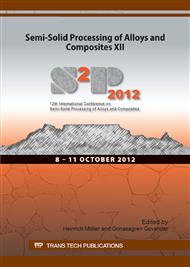[7]
days
ΔWeight
Weight loss
Corrosion rate3
(cm2 )
(g)
(g)
(g)
(mg day-1 dm-2 )
(μA cm-2 )
AM60 DIE-CASTING
Google Scholar
[4]
6.1329
6.1288
0.0041
14.6
13.5
AM60 R-HPDC (without heat treatment)
4
7.3081
7.3048
0.0033
11.8
10.8
AM60 R-HPDC (with heat treatment)
2
3.1766
3.1749
0.0017
12.1
11.2
AZ91 DIE-CASTING
Google Scholar
[4]
5.6295
5.6277
0.0018
6.4
5.9
AZ91 R-HPDC (without heat treatment)
4
6.1064
6.1049
0.0015
5.4
4.9
AZ91 R-HPDC (with heat treatment)
2
4.0331
4.0325
0.0006
4.3
3.9
AM50 DIE-CASTING
Google Scholar
[4]
0.814
0.8116
0.0024
8.6
7.9
AM50 R-HPDC (without heat treatment)
4
6.4776
6.4738
0.0036
13.6
12.5
AM50 R-HPDC (with heat treatment)
2
3.5172
3.5166
0.0006
4.3
3.9 As shown in Table 1, die-cast AM60 has higher corrosion rates than that of die-cast AM50 and AZ91. In the case of AM50 samples the highest corrosion rate is that of R-HPDC samples not thermally treated. For all the samples the corrosion rates of heat treated R-HPDC are lower than those of untreated R-HPDC and die-cast alloys. In comparison with die-cast samples the corrosion rates of the alloys R-HPDC with heat treatment are significantly lower. The corrosion current densities obtained from the weight loss measurements are greater with respect to those derived from dynamic polarization measurements, even though they are in good agreement for what concerns the ranking. In particular, for the three types of AM60 alloy samples the calculated corrosion current densities by weight loss have proved to be higher than those of the other alloys and among them quite similar. Summary In the light of the achieved results, we can state that the electrochemical tests have shown better corrosion resistance for heat treated R-HPDC AM50 alloy in comparison with untreated R-HPDC AM50 and die-cast AM50. For AZ91 alloy the results are controversial and further investigations are necessary, while for AM60 the die-cast corrosion resistance measured by electrochemical tests is higher than that of R-HPDC alloys. On the contrary, weight loss measurements show a better corrosion resistance of the heat treated R-HPDC alloys in comparison with the die-cast and the untreated R-HPDC. References
Google Scholar


